You'll want to maintain indoor relative humidity levels between 40-60% to effectively control unwanted static electricity in your home or workplace. At levels above 55%, static electricity is eliminated completely, while levels below 40% substantially increase static buildup. Temperature and heat sources can affect these humidity levels, so it's important to monitor them using devices like hygrometers. You can achieve ideal moisture levels through various humidification methods, including evaporative humidifiers, air purifiers, or whole-house systems. Understanding the relationship between humidity and static electricity opens up a world of effective prevention strategies.
Static Electricity Basics
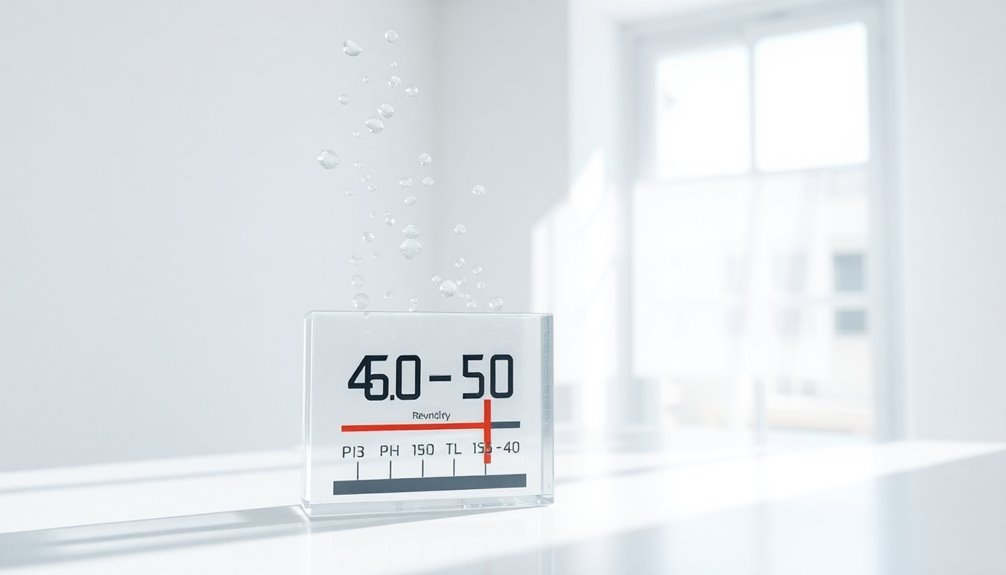
Static electricity frequently occurs in our daily lives, yet many people don't fully understand its fundamental principles. When you rub certain materials together, electrons transfer between them through a process called the triboelectric effect. This transfer creates an imbalance of positive and negative charges, resulting in static electricity.
You'll find that static electricity builds up more easily in dry conditions where there's less moisture to dissipate the charges. The process involves atoms, which contain protons (positive charges), electrons (negative charges), and neutrons (neutral). Low humidity contributes significantly to increased static buildup.
When materials exchange electrons, some surfaces become positively charged while others become negatively charged.
You can observe this charge interaction when like-charged surfaces repel each other, while oppositely charged surfaces attract. The charges accumulate particularly well on insulators or non-conductors, such as plastic or wool.
Even at levels below 1 kV, static electricity can cause significant problems in production environments, including equipment damage and material handling issues. You'll notice these effects more prominently when the relative humidity drops below 40%, especially near heat sources that reduce local air moisture.
Understanding Humidity Measurement
When you're measuring humidity for static control, you'll need to understand both relative humidity (percentage of moisture in the air) and absolute humidity (actual water vapor content), as well as dew point (temperature at which condensation occurs).
You can test humidity levels using various methods, including electronic hygrometers, psychrometers, and dew point meters, each offering different levels of accuracy and cost-effectiveness. Capacitive MEMS IC sensors are commonly used for their extended temperature range capabilities and good accuracy.
The dew point measurement is particularly important for static control because it indicates the actual moisture content regardless of temperature changes, making it a reliable indicator for maintaining consistent humidity levels.
Relative Vs Absolute Humidity
Understanding how humidity affects static electricity requires knowledge of two distinct measurements: relative and absolute humidity. While relative humidity represents the percentage of water vapor the air currently holds compared to its maximum capacity at a given temperature, absolute humidity measures the actual amount of water vapor per cubic meter of air, regardless of temperature.
Both types of humidity play essential roles in controlling static electricity. Higher levels of either measurement will help dissipate static charges more quickly by increasing surface conductivity and reducing electrical resistance. Hygrometers and humidity sensors are commonly used to measure relative humidity in indoor environments.
When you're dealing with warm air, it can hold more moisture than cold air, which means you might have high absolute humidity but lower relative humidity in warm conditions.
For practical purposes, you'll want to maintain relative humidity between 40-60% indoors to effectively control static electricity while ensuring comfort and preventing other issues like mold growth. Remember that temperature changes can affect relative humidity even when absolute humidity remains constant.
If you lower the temperature in a room, the relative humidity will increase, potentially leading to faster static electricity dispersal.
Humidity Testing Equipment Methods
Through a variety of measurement techniques, modern humidity testing equipment offers precise ways to monitor and control moisture levels in the air.
Capacitive MEMS IC sensors provide reliable readings with ±2-5% accuracy while simultaneously measuring temperature, making them ideal for general-purpose monitoring.
For industrial applications, you can use resistive sensors that detect humidity through resistance changes, or opt for wet/dry bulb psychrometers that measure moisture through evaporation cooling. These sensors are particularly effective in high-temperature environments where durability and consistent readings are essential.
If you're working with trace moisture measurement, oscillating quartz crystal sensors deliver accuracy within ±10% from 1 to 2,000 PPM.
When you need the highest precision, consider chilled mirror dew point sensors. Though they require regular maintenance and come at a higher cost, they're often used as calibration standards.
For thorough environmental testing, you'll benefit from devices like the PCE-VA 20, which measures multiple parameters including air flow, relative humidity, and dew point temperature.
You can also use specialized equipment like the Torontech TT-TH Series chambers for material testing, which incorporate automatic humidification and air circulation systems to maintain consistent conditions throughout your testing procedures.
Dew Point Significance
Dew point readings serve as a vital indicator of moisture content in the air, providing a more reliable measure than relative humidity alone. You'll find that dew point directly relates to your air's saturation point, which occurs when the air temperature equals the dew point temperature, resulting in 100% relative humidity. Higher pressure levels can raise the dew point temperature, requiring more moisture control for static prevention.
When you're monitoring static electricity control in your environment, understanding dew point becomes essential. A higher dew point indicates more moisture in the air, which helps prevent static buildup. You can't have a dew point higher than the air temperature, but you can use it to predict when condensation might occur.
| Air Condition | Dew Point Impact | Static Control Effect |
|---|---|---|
| Below 40% RH | Low Dew Point | High Static Risk |
| 40-55% RH | Moderate Dew Point | Reduced Static Risk |
| Above 55% RH | High Dew Point | Minimal Static Risk |
| Temperature = Dew Point | 100% RH | No Static Risk |
| Large Temp-Dew Point Gap | Low RH | Maximum Static Risk |
For accurate measurements, you'll want to use specialized equipment like chilled mirror sensors or precision dew point instruments, especially in industrial settings where static control is vital.
Optimal Humidity Target Ranges
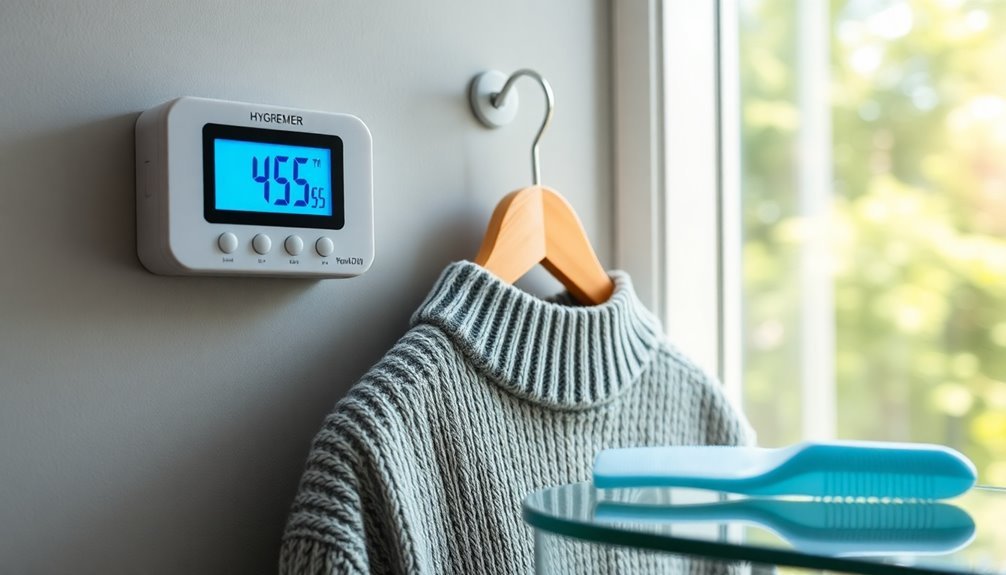
You'll want to maintain indoor humidity levels between 40-60% RH to effectively control static electricity in your home.
For technical facilities and sensitive equipment areas, you should aim for the higher end of this range (55% RH or above) to completely eliminate static buildup.
Your specific target within these ranges may vary depending on your local climate and the sensitivity of your electronics, but staying above 40% RH is essential for preventing unwanted static discharges. During colder months, dry winter conditions significantly increase static electricity generation, making humidity control even more crucial.
Ideal Range For Homes
When it comes to managing static electricity in your home, maintaining the right humidity level is essential. You'll want to keep your indoor relative humidity (RH) between 40-60% for the best results. At levels above 55%, you'll eliminate static electricity completely, while maintaining 40% allows static charges to dissipate safely without causing those uncomfortable shocks. The triboelectric effect causes static buildup when materials rub together, making humidity control crucial.
| Humidity Level | Static Effect | Action Needed |
|---|---|---|
| Below 40% RH | High buildup | Increase humidity |
| 40-55% RH | Controlled | Maintain level |
| Above 55% RH | Eliminated | Monitor only |
To achieve these ideal levels, you'll need to think about several factors that affect indoor humidity. Your home's temperature, heat-generating appliances, and flooring materials all play important roles. If you're experiencing frequent static shocks, you can install an evaporative humidifier or humidifying air purifier to regulate moisture levels. These systems help you maintain consistent humidity while monitoring actual levels in your space. For the most effective static control, you'll want to choose a system that can provide precise humidity regulation without generating excess heat, such as an evaporative or Dry Fog system.
Technical Facility Requirements
Technical facilities' static control demands precise humidity management across different industrial environments. You'll need to maintain relative humidity (RH) above 55% to effectively prevent static build-up in your manufacturing spaces. This threshold is particularly vital if you're operating in packaging, printing, paper, plastics, textiles, electronics, automotive manufacturing, or pharmaceutical industries.
Your facility's heat-generating machines can create dry air pockets that require targeted solutions. You'll want to install localized humidification systems near these areas to maintain consistent RH levels.
For larger spaces, you can implement direct room humidifiers or atomizing nozzles to achieve thorough coverage.
Temperature fluctuations will affect your humidity control's effectiveness, so you'll need to monitor both factors carefully. The MIL-HDBK-263 Standard emphasizes this relationship between temperature and RH in static control.
When you can't maintain high RH levels in certain areas, consider using ionized air as an alternative solution. However, be cautious with extremely high humidity levels, as they can cause problems like corrosion and PWB delamination during soldering processes.
Your specific facility requirements will determine whether you need evaporative humidifiers, dry fog systems, or localized spray solutions.
Environmental Moisture Impact
The relationship between environmental moisture and static electricity plays a crucial role in maintaining safe, productive workspaces. When moisture levels in the air drop below 40% relative humidity, you'll notice a significant increase in static electricity buildup. This is particularly noticeable during winter months when heating systems dry out indoor air, creating perfect conditions for static charges to accumulate rather than dissipate.
Your indoor environment's moisture content directly influences how static charges behave. Water molecules in humid air act as natural conductors, allowing potentially harmful static charges to discharge gradually and safely. You'll find that maintaining humidity levels between 40-60% RH provides essential protection against unwanted static electricity.
Weather Impact:
Cold, dry conditions increase static electricity risks, while warmer, damper weather naturally reduces static buildup.
HVAC Effects:
Your heating and air conditioning systems can create dry conditions that promote static electricity throughout the year.
Control Methods:
By monitoring and adjusting indoor humidity levels, you can effectively manage static electricity before it causes problems with equipment or products.
These environmental factors affect various industries, from electronics manufacturing to pharmaceutical processing, making proper humidity control essential for operational success.
Indoor Humidity Control Methods
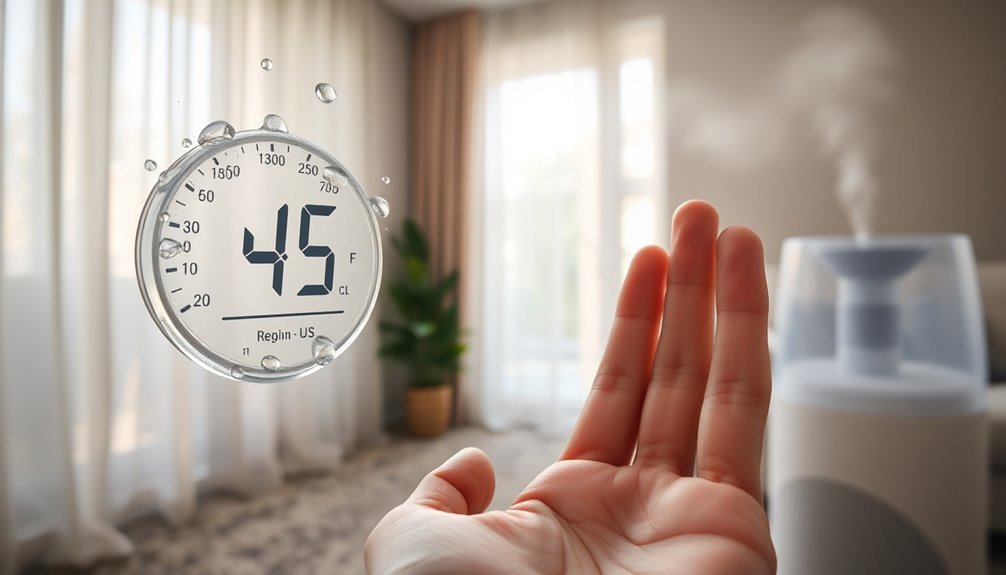
Throughout any given day, you'll need different methods to maintain ideal indoor humidity levels for static electricity control. You can choose between ventilation strategies and dedicated humidity control devices, depending on your specific needs and climate conditions.
While ventilation methods like exhaust fans and natural airflow can help manage humidity, they're only effective when outdoor humidity is lower than indoor levels.
For more reliable control, you'll want to think about whole-home humidity control devices. Dehumidifiers and humidifiers offer superior moisture management compared to ventilation alone, helping you maintain perfect conditions that prevent static electricity buildup.
You can select from various dehumidification technologies if you need to reduce moisture. Cooling coils, which use chilled water or refrigerants, are the most common method.
Alternatively, liquid desiccant systems using lithium chloride or solid desiccant systems with silica gel can effectively absorb excess moisture.
To eliminate static electricity, you'll want to maintain relative humidity above 65%. However, be cautious not to exceed this level substantially, as excessive moisture can lead to condensation and potential damage to your electronics and machinery.
Seasonal Humidity Challenges
While indoor humidity control methods are effective year-round, you'll face distinct challenges as seasons change. Winter brings particularly troublesome conditions as cold air holds less moisture, and your heating system further reduces indoor humidity. This creates an ideal environment for static electricity buildup, leading to uncomfortable shocks and potential damage to your electronic devices.
Summer presents its own set of challenges, as high humidity levels can cause electrical malfunctions and corrosion in your electronics. You'll need to balance between preventing static electricity and avoiding excessive moisture that could harm your devices.
Air conditioning can also contribute to static electricity problems by creating dry spots in your space.
To effectively manage seasonal humidity challenges, focus on these key areas:
- Monitor absolute humidity levels rather than relative humidity, as it's more reliable for static control
- Adjust your humidity control methods based on seasonal changes – increase humidification in winter and manage dehumidification in summer
- Pay special attention during seasonal shifts when your HVAC system switches between heating and cooling modes
Remember that static electricity can occur in any season, but you'll need different approaches to maintain ideal humidity levels throughout the year.
Electronics Protection Best Practices
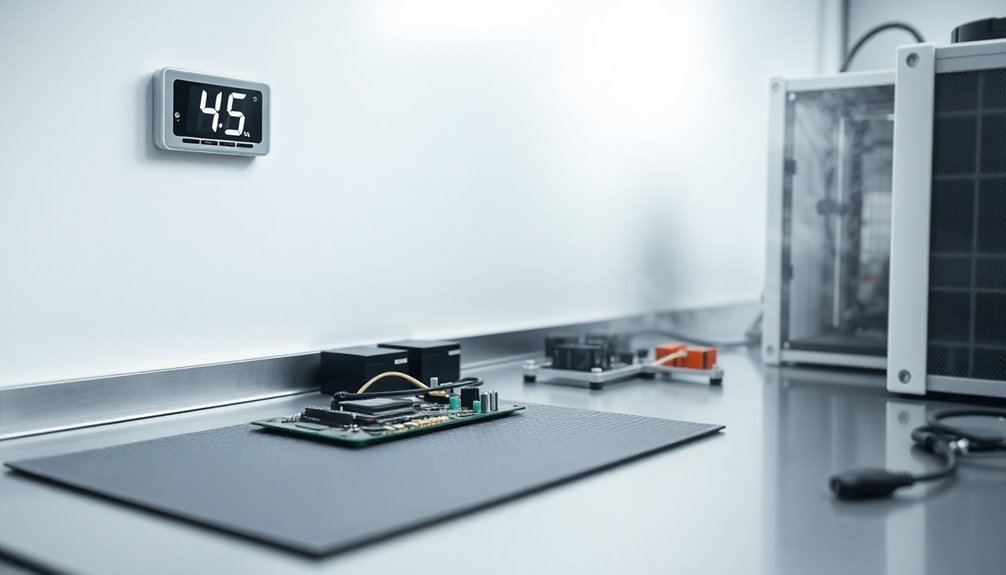
You'll need to start by properly grounding all your electronic equipment using approved ESD-safe materials and wrist straps to prevent damaging static discharges.
It's essential to monitor the humidity levels around your devices, aiming to maintain them between 40-60% relative humidity using appropriate humidification systems.
Store your sensitive electronics in anti-static bags or containers specifically designed for ESD protection, and always handle components in designated ESD-protected areas.
Grounding Equipment Safely
Establishing proper equipment grounding procedures stands as a critical first line of defense against electrical hazards and static discharge. You'll need to guarantee your grounding system effectively directs fault currents into the earth while maintaining minimal impedance.
When you're working with electrical equipment, it's crucial to use protective devices like fuses and circuit breakers that can quickly interrupt currents in faulty circuits.
For safe grounding practices in your workspace, you'll want to:
- Set up an ESD-Protected Area (EPA) where all objects connect to ground, including antistatic mats and ESD wrist straps
- Install TVS diodes in parallel with protected circuits to shunt excess energy safely to ground
- Optimize your PCB layouts to create the shortest possible path to ground, reducing impedance
When you're applying personal protective grounds, always connect the grounded end first, followed by phase conductors starting with the one closest to your body. Remember to remove them in reverse order.
Your ground cables should be properly sized and durable enough to handle the system's requirements. By implementing these measures, you're creating a safer workplace while protecting sensitive electronic components from damage.
Monitor Device Humidity Levels
Beyond proper grounding practices, maintaining ideal humidity levels plays a key role in protecting electronic devices from static electricity damage. You'll want to keep humidity levels between 30% and 70% in your electronics manufacturing environment, with 40% relative humidity (RH) being the ideal target for preventing electrostatic discharge (ESD).
When humidity drops below 40% RH, you're facing markedly increased static risks. At levels under 20%, static voltages can reach dangerous heights – up to 6,000V at a regular workbench and 35,000V when walking across carpet.
To prevent these hazards, you'll need to monitor and maintain proper humidity consistently.
You can implement several effective solutions to control humidity. Think about installing evaporative humidifiers or integrated cooling systems for facility-wide control.
For localized protection around heat-generating equipment, use spray systems or ceiling-mounted atomizing nozzles. These solutions help maintain stable manufacturing conditions and protect sensitive components.
Remember to adjust your humidity control strategy based on your specific manufacturing needs and location. While 50% RH works well for many facilities, you'll need to take into account your particular electronic components' sensitivity and ambient environmental conditions when setting your target humidity levels.
Anti-Static Storage Solutions
Protection against static electricity requires implementing proper storage solutions for sensitive electronic components. When you're handling electronics, you'll need specialized containers and packaging materials designed to prevent static discharge and protect your devices from damage. These solutions incorporate materials like High-Density Polyethylene (HDPE) and carbon black to effectively dissipate static charges.
You'll find various anti-static storage options available, each serving specific purposes in electronics protection:
- Anti-static containers and boxes made from conductive materials that quickly dissipate charges – these are often blue-colored and ideal for long-term storage.
- Static shielding bags featuring pink anti-static polyethylene film – these provide excellent protection during transportation and handling.
- Custom storage solutions designed for specific applications – these can be tailored to meet your unique requirements in manufacturing or laboratory environments.
When selecting storage solutions, verify they're appropriate for your specific needs. If you're working in a cleanroom or laboratory setting, you'll need containers that meet stringent requirements for both static control and contamination prevention.
Remember that proper storage solutions work best when combined with appropriate humidity levels between 40% and 60%.
Workplace Static Prevention
In accordance with modern workplace safety standards, implementing thorough static prevention measures is essential for protecting both equipment and personnel. You'll need to focus on multiple aspects of your workplace environment to effectively control static electricity.
Start by grounding all conductive objects and electrical equipment. You should install ESD floor coatings and provide anti-static mats in areas where employees handle sensitive electronics.
Make sure your staff wears appropriate anti-static clothing and footwear, and equip them with anti-static wristbands when working with sensitive components.
Maintain your workplace humidity between 40% and 60% using high-pressure air humidifying systems. You'll want to monitor both relative and absolute humidity levels, as they work together to prevent static buildup. Don't forget that static isn't just a winter problem – it requires year-round attention.
Design your workstations with static reduction in mind by implementing proper cable management and minimizing clutter. You should also use ionizers in high-risk areas and store sensitive components in static-safe containers.
Regular inspections of these measures will guarantee they're working effectively and protecting your workplace from static-related incidents.
Monitoring Humidity Levels
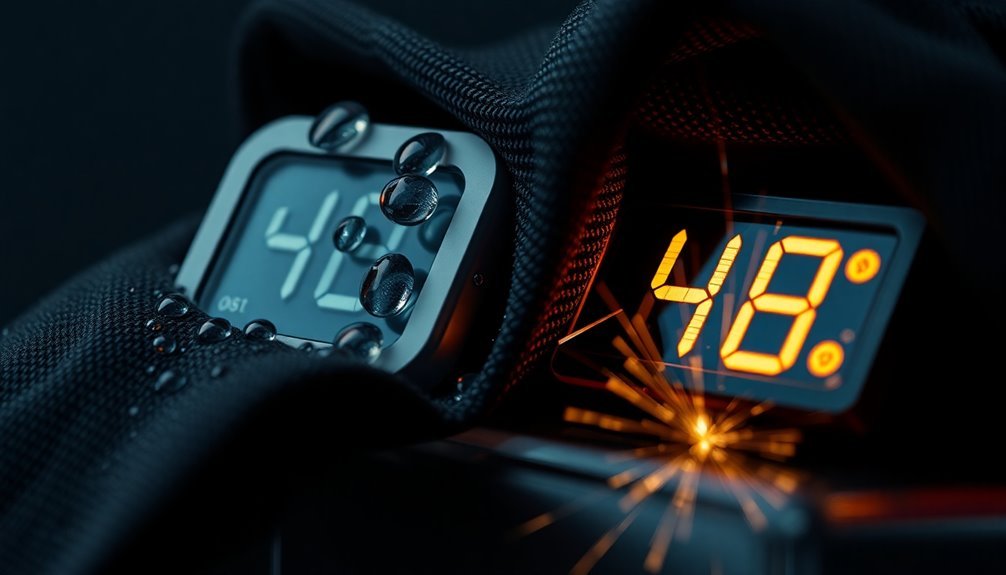
Since maintaining proper humidity levels directly impacts static electricity control, you'll need to implement a robust monitoring system in your facility.
When your indoor environment's relative humidity falls below 40%, you're at risk for static electricity buildup and potential electrostatic discharges. To eliminate static completely, you'll want to maintain levels above 55% RH, though industry standards like ANSI/ESD S20.20-1999 allow for a broader range of 30% to 70%.
You can effectively control humidity through various methods, focusing on these key ranges and approaches:
- Install evaporative humidifiers for consistent moisture levels throughout your facility
- Deploy localized spray systems near heat-generating equipment to maintain ideal humidity
- Implement integrated evaporative cooling systems to regulate both temperature and moisture content
Your monitoring strategy should align with NASA-STD-8739.7 guidelines, which recommend maintaining humidity between 40% and 60%.
If you're managing an electronics manufacturing facility or other sensitive environment, you'll need high-efficiency humidification systems for precise control.
Remember that consistent climate control is essential, and you'll want to minimize heat-generating machines and remove carpeting to reduce static electricity risks.
Common Static Prevention Mistakes
Four critical mistakes commonly undermine static electricity prevention efforts in industrial settings.
The first mistake is inadequate training and awareness, where companies fail to provide thorough ESD training to their employees. You'll need to implement regular training sessions and refresher courses to maintain high awareness levels and guarantee proper handling procedures are followed.
The second mistake involves neglecting personal grounding. You must enforce strict policies requiring the use of wrist straps and heel grounders in ESD-sensitive areas, along with regular testing and maintenance of these devices.
Third, improper workstation setup poses substantial risks. You should equip all workstations with grounded mats and conductive surfaces, guaranteeing every surface that comes in contact with electronic components is properly protected.
Finally, using non-ESD safe materials is a critical error that can lead to component damage. You'll need to invest in ESD-safe packaging, storage solutions, tools, and equipment to maintain a truly static-safe environment.
Cost-Effective Humidity Solutions
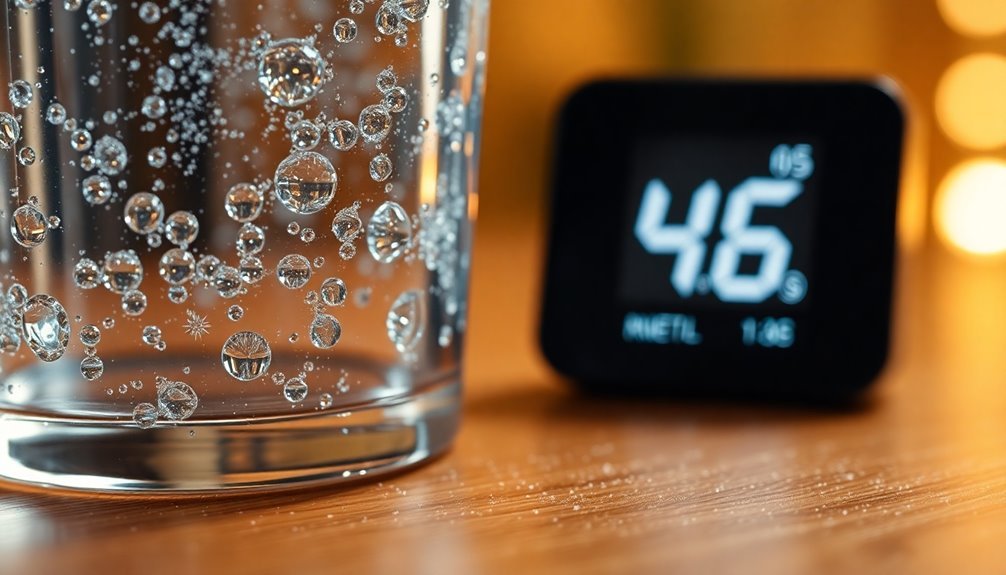
Although controlling static electricity may seem complex, maintaining proper humidity levels offers one of the most cost-effective solutions for your facility. You'll find that keeping relative humidity between 40-60% substantially reduces static buildup by allowing charges to leak naturally to the ground through the air.
When you implement proper humidification systems, you're not just preventing static – you're also protecting your equipment and reducing long-term operational costs.
Your options for humidity control include:
- Direct room humidifiers for large spaces like manufacturing floors or printing halls
- Localized spray systems targeting specific areas near heat-generating machines
- Evaporative humidifiers that provide consistent climate control while managing temperature
You can maximize cost-effectiveness by choosing the right system for your specific needs. If you're dealing with large spaces, direct room humidifiers offer thorough coverage, while localized systems work best for targeting dry micro-climates around specific equipment.
Remember to monitor humidity levels regularly and maintain your systems properly to guarantee their effectiveness. By preventing equipment damage and operational disruptions through proper humidity control, you'll see noteworthy returns on your investment while maintaining a static-free environment.
Frequently Asked Questions
Can Static Electricity Still Occur in Rooms With Water Features or Fountains?
Yes, you'll still experience static electricity in rooms with water features if there are localized dry areas. While fountains increase humidity, you'll need consistent moisture levels above 55% RH throughout to eliminate static completely.
How Quickly Does Static Electricity Dissipate When Humidity Levels Are Increased?
You'll notice static electricity dissipates faster as humidity rises. When you maintain levels between 40-60% RH, charges scatter quickly, and they'll completely disappear once humidity exceeds 55% in your space.
Do Air Ionizers Work Better Than Humidifiers for Controlling Static Electricity?
You'll find that both methods work effectively, but differently. Air ionizers target specific areas and work instantly, while humidifiers provide broader coverage and ongoing protection. Your choice depends on your facility's specific needs.
Does the Type of Flooring Material Affect Static Buildup at Different Humidity Levels?
Yes, your flooring choice substantially impacts static buildup at any humidity level. You'll notice carpets create more static than hardwood or tile, while ESD flooring maintains consistent performance regardless of moisture levels.
Can Excessive Humidity Cause More Problems Than the Static Electricity Itself?
Yes, you'll face more serious problems with excessive humidity than static electricity. High moisture levels can damage your home's structure, trigger health issues like asthma, and promote dangerous mold and mildew growth.
In Summary
You'll find maintaining indoor humidity between 40-60% effectively controls unwanted static electricity in most environments. Don't let levels drop below 30%, as that's when static problems typically begin. If you're experiencing static issues, invest in a reliable humidifier and humidity monitor. Remember, consistent moisture control isn't just about comfort—it protects your electronics and prevents those annoying static shocks.

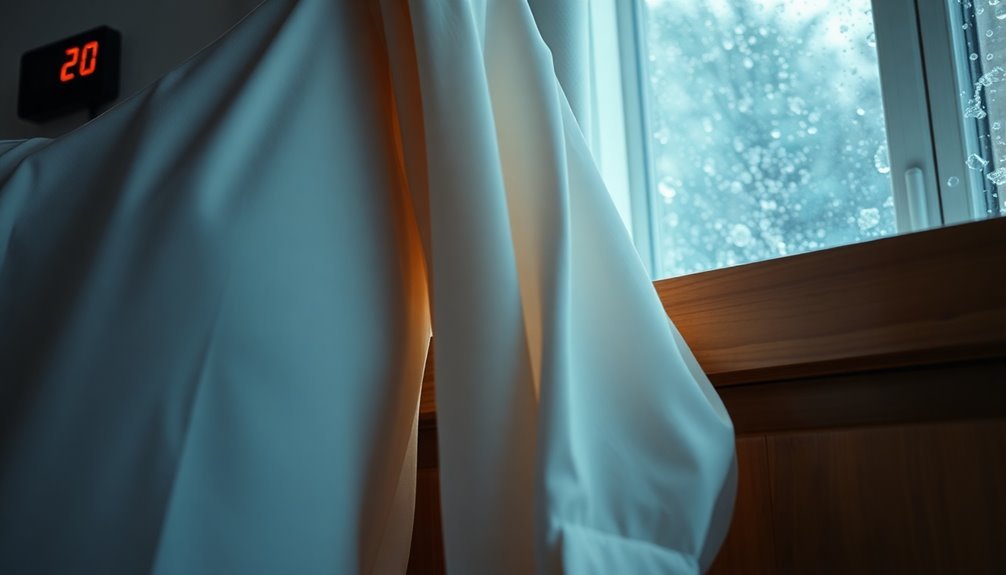



Leave a Reply